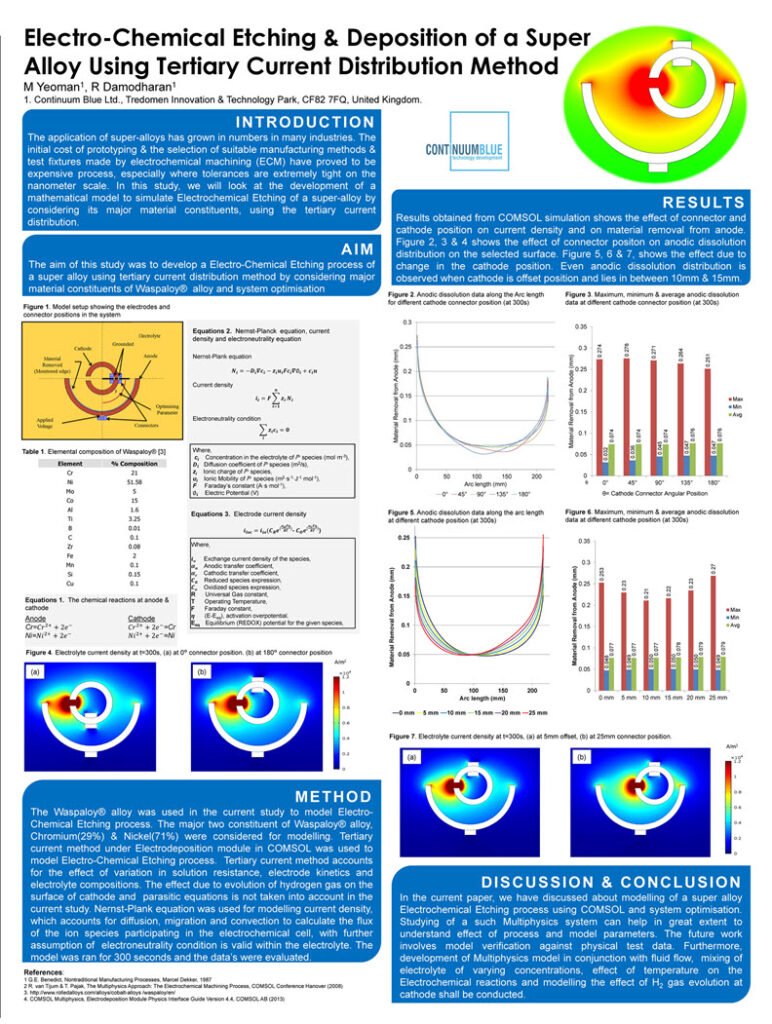Continuum Blue has worked on several electrochemical process and species simulations, including deposition, electropolishing and removal for the medical, aerospace, defence and electronics industries.
Electrochemical manufacturing processes are industrial processes that utilize the principles of electrochemistry to produce materials or products. These processes involve the use of electrical energy to carry out chemical reactions, which can result in the creation of a wide range of products.
Some common examples of electrochemical manufacturing processes include:
- Electroplating: This process involves the deposition of a metal coating onto a substrate using an electrolytic solution. Electroplating is commonly used to improve the corrosion resistance, wear resistance, and aesthetic appearance of metal parts.
- Electropolishing: Electropolishing is a process that uses an electrolytic solution to remove surface material from a metal part. The result is a smoother and more polished surface finish that can improve the performance and aesthetics of the part.
- Electroforming: Electroforming is a process that uses an electrolytic solution to deposit metal onto a mold or substrate. The resulting metal object can be used as a mold or a finished product, depending on the application.
- Electrolysis: Electrolysis is the process of using electrical energy to break down a chemical compound into its constituent parts. This process is commonly used to produce chemicals such as chlorine and hydrogen, which are used in a wide range of industrial applications.
- Battery production: The production of batteries involves a series of electrochemical reactions that convert chemical energy into electrical energy. This process is used to produce a wide range of batteries, including lead-acid batteries, lithium-ion batteries, and nickel-metal hydride batteries.

Overall, electrochemical manufacturing processes play a critical role in many industries, including automotive, aerospace, electronics, and energy. They offer a range of benefits, including increased efficiency, improved product quality, and reduced environmental impact.
Electroplating is a commonly used process in the manufacture of electronic components. To ensure that the electroplating process produces high-quality, reliable components, there are several critical design characteristics that must be taken into consideration. These include:
- Plating material: The plating material used in the electroplating process must be carefully chosen to ensure that it meets the requirements of the electronic component. Common plating materials include gold, silver, copper, and nickel.
- Plating thickness: The thickness of the plating layer must be carefully controlled to ensure that it meets the desired specifications for the component. The thickness of the plating layer can affect the component’s electrical conductivity, durability, and resistance to corrosion.
- Plating uniformity: The electroplating process must be designed to ensure that the plating layer is applied uniformly across the surface of the component. Non-uniform plating can result in poor electrical performance or premature failure of the component.
- Adhesion: The plating layer must adhere tightly to the underlying substrate to ensure that it remains in place during use. Poor adhesion can result in flaking or peeling of the plating layer, which can cause electrical shorts or other issues.
- Surface preparation: The surface of the component must be properly prepared before electroplating to ensure that the plating layer adheres properly. This may involve cleaning, etching, or other surface treatment processes.
Overall, designing an electroplating process for electronic components requires careful consideration of these and other critical design characteristics to ensure that the resulting components meet the required specifications for performance, reliability, and durability.
